Snowpack, Runoff, and Predicted Summer Fishing Conditions Update for May 1, 2024
Posted on May 1st, 2024 in Season Forecasts, Weather & Water Conditions
Winter and early spring 2023-2024 have been warm and dry in Yellowstone Country, just like it has just about everywhere except California through Colorado. For a while we were flirting with record-low snowpack and the potential for a very short fishing season. After strong improvement from mid-January through March, April saw warm and dry weather with an accompanying sharp decline in snowpack and an early pulse of spring runoff (weeks early). We are unfortunately now looking at tough conditions again in late summer and early fall.
Because of anticipated low and warm streamflows and a forecast for a hot, dry summer, we encourage anglers to visit sometime between June 15 and July 15 if you’re looking for consistent summer-type fishing with dry-dropper combos, fast, cold flows, etc. July 20 through August are likely to see very low water and widespread 2:00PM mandatory closures. Early September will see better conditions, but low, clear water will still make for difficult fishing on sunny days. Only in October and November can we be sure of aggressive fish again.
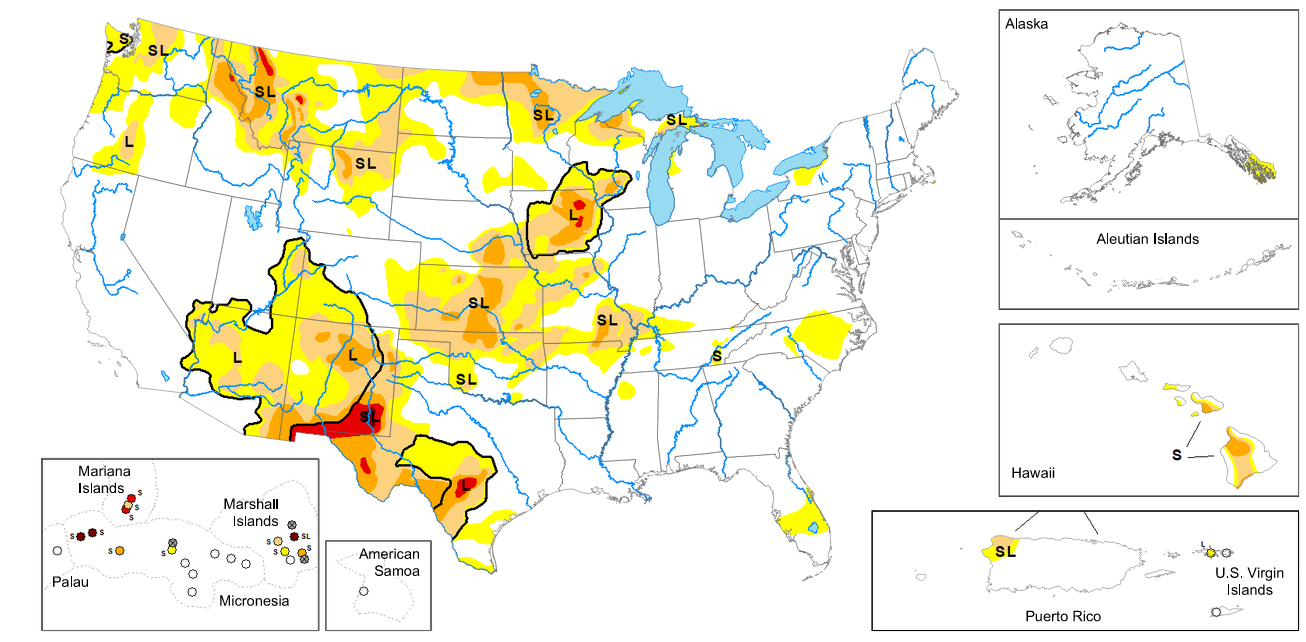
Current United States drought conditions. Our area of SW Montana and NW Wyoming ranges from abnormally dry (yellow) to severe drought (orange).
With Yellowstone Park opening portions of the Gardner and Madison Rivers to year-round fishing beginning November 1, this may be a year to skip August and come in early November instead, especially if you’re an angler who likes to walk-wade and doesn’t mind cold weather fishing.
Anglers who visit in late summer and early fall must be flexible as far as destinations, tactics, trip start times (we will likely want to meet before dawn) and durations (morning half-days might be the way to go in August) and even target species. We cannot guarantee typical fisheries like the Yellowstone River in Paradise Valley will even be open in August, whereas oddball fisheries like the Toston Dam section of the Missouri River will certainly have aggressive carp and even some pike and walleye at the same time.
Note that the maps we used to include on these posts are no longer produced. Instead, find the replacement products here: NWCC Maps.
Winter and Spring Weather, Remaining Snowpack, and Runoff
In Livingston we saw our heaviest snowstorm prior to late January in late October. That about sums up our winter.
As of mid-January, we were sitting at around 2/3 of our normal snowpack. Conditions improved steadily due to wet weather in February and March, so that by late March we were sitting at roughly 80–90% snowpack in most of our operations area. Unfortunately, April was very warm and somewhat dry. This was particularly true of late April, with the exception of the past few days. We saw our snowpack basically collapse in late April, particularly in basins to the north, which are generally at lower elevations.
We have also seen an early pulse of spring runoff. This began approximately April 25, roughly two weeks ahead of schedule and almost record-early. Flows have dropped and the Yellowstone River is marginally fishable again already and should continue to clear over the next few days, but flows are likely to be remain above normal. This early runoff is exactly what we didn’t need to preserve water for summer. Other rivers in Montana have not yet entered runoff.
Snowpack within our operations area now ranges from 39% of normal to 81% of normal. The most important basins in our operations area, the upper Yellowstone Basin in Montana and in Wyoming, run 68% of normal and 74% of normal. The Montana number includes the Wyoming number (since the Yellowstone runs downhill from WY to MT), so actual numbers in Montana are even lower.
Here are the snowpack maps:

Northwest Wyoming snowpack data. The Madison Headwaters and Yellowstone in WY basins impact our operations and basically refer to Yellowstone Park.
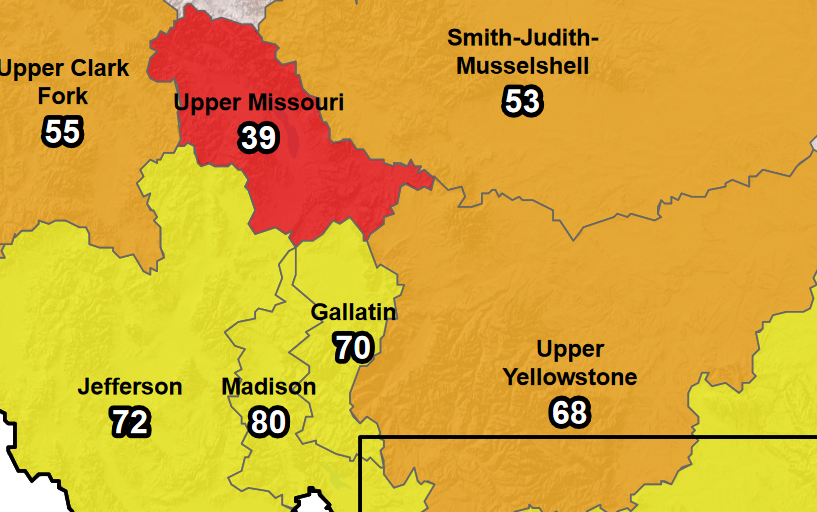
Snowpack in our operations area as of May 1. The most important basins in Montana are the Upper Yellowstone and Madison.
The overall precipitation numbers are slightly better, since we had a warm winter and saw a lot of rain, particularly at lower elevations. Since the ground is now melted under roughly 7300 feet elevation, and has been melted for some time under 6000 feet, a lot of this precip has soaked in. Coupled with a fairly wet year last year, soil moisture is not as bad as it could be. That said, we’d still like to see these numbers higher.
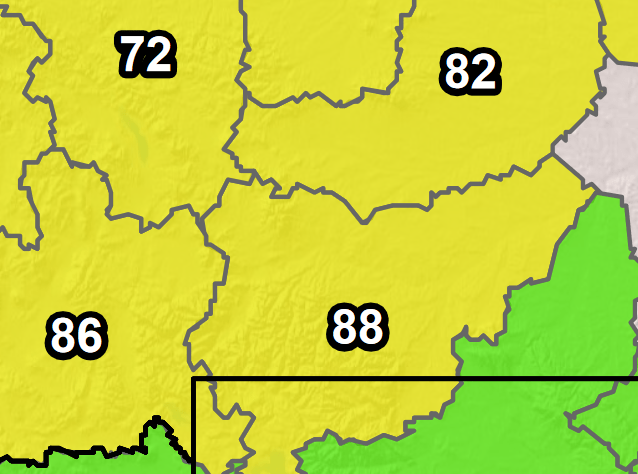
Water year precipitation map for the core basins in our operations area. These numbers are a bit better than snowpack, but obviously still low.
While snow tends to continue to melt once it has started, we are aided by the current outlooks for May. Over the first half of the month, we are looking at a continuation of the cooler and wetter weather we’ve seen over the past 3–4 days. It even snowed a bit in Livingston overnight last night, and quite a bit more at high elevations. It should continue to snow most days we have precip up high. This is exactly what we need to bring the Yellowstone back into fishable shape for the first half or even 2/3 of May, as well as preserving snowpack.
Here is the current 8–14 days outlook covering early May.

Early May outlook courtesy NOAA. The 6-10 day outlook is similar.
Here is the outlook for May as a whole. It’s not quite as friendly as the outlook for early May, but at least it’s not calling for high temps and dry weather.
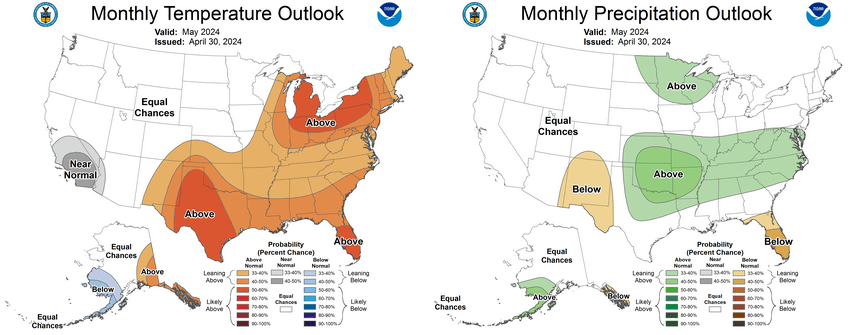
May 2024 NOAA climate outlook.
Outlooks for Spring and Summer
Outlooks for spring and summer are not what we want. The outlook for May through July (spring and early summer) is calling for warmer-than-normal temperatures but perhaps normal precip. Hopefully we keep near-normal precip at least.
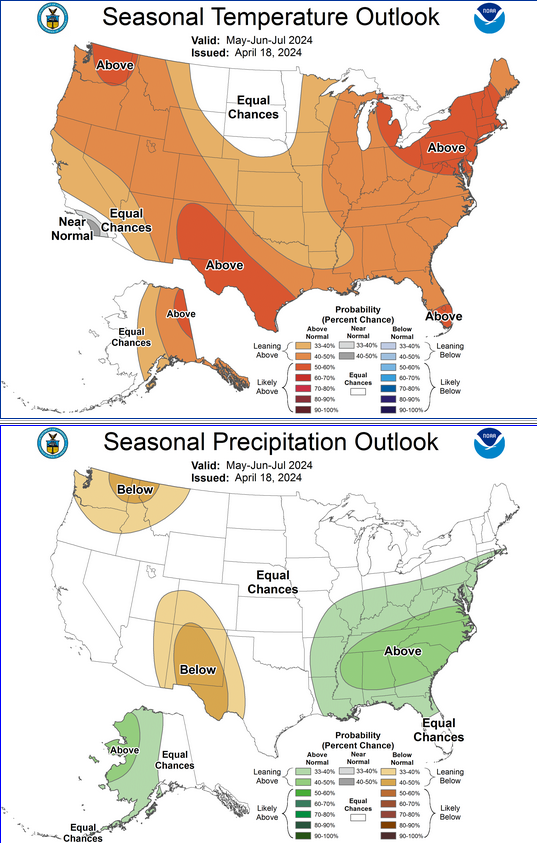
The late summer outlook is even worse. We’re right in the bullseye for high likelihoods of hotter and drier than normal weather. This is almost never ideal, but on the heels of a low snowpack winter, it’s a recipe for tough conditions in late summer.
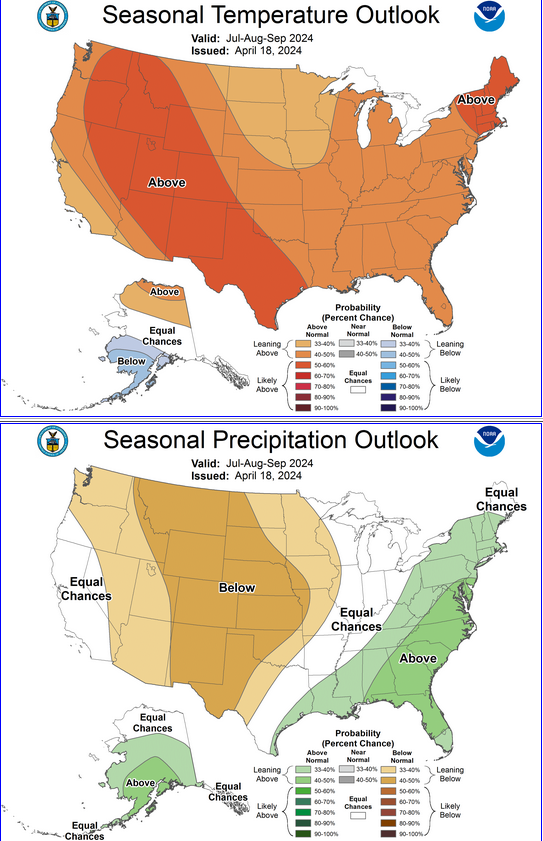
The only bright spot is that NOAA is now forecasting La Nina for next winter. The first year of a La Nina folloing a strong El Nino (which we had this past fall and winter, but which is not fading fast) is typically cold and wet to the northwest part of the continental USA, including Montana. We certainly hope so… In fact the hot/dry summer outlook is actually common for us in La Nina years. We like to see “LN” winters and springs, but “EN” summers as far as keeping temps in check and getting a little precip.
General Outlook for Summer Fishing
We are now certain to have an extremely low snowpack and below-normal but not awful soil moisture. Even with a potential normal or even late start to the heaviest part of the spring runoff due to the cool weather we’re seeing right now, the early surge of runoff in late April means we’re going to see an overall early end to the spring melt and a low overall peak runoff. Many fisheries will not experience an unfishable spring melt. While this is not uncommon on places like the Lower Madison River and Firehole River, it will extend to fisheries which usually do experience substantial melts, including many fisheries in Yellowstone Park and conceivably even some rivers outside it, such as the Boulder River.
Because of this, we anticipate an early start to summer fishing on our most popular and important fisheries, with the best fishing running much earlier in the summer than normal. In general, we anticipate the peak 30-day period as far as consistency to be from June 15 through July 15. Larger rivers in Montana will slant slightly earlier than smaller wade-only streams in Yellowstone Park. The Yellowstone River should fish great in the latter half of June, while the Lamar is likely to be better July 4–15, for example.
Late summer (July 20 through August) will see low water and difficult fishing conditions. 2:00PM closures now seem certain on most area rivers. These closures will almost certainly impact the entire Yellowstone River from the Yellowstone Park boundary to Laurel and may impact all area rivers, including those that seldom see closures such as the upper Madison River (50-Mile Riffle) and even the Missouri River below Canyon Ferry Reservoir. Yellowstone Park is likely to close all streams at 2:00. They do this to limit late-day pressure on small mountain creeks that generally remain cold enough, but cannot handle the full weight of angling pressure moving from the larger famous name waters after lunch.
Complete 24hr fishing closures are likely on the lower Madison River, the lower Gallatin River, the entire Jefferson River, and a few small odds and ends. Note that none of these complete closures impact places that fish well in late summer, anyway. We cannot rule out 24hr closures on the Yellowstone River, though it will take record heat in July and early August for these to occur.
The first half of August in particular is likely to be grim, especially on float fisheries outside YNP where water temps slant warmer than higher in the mountains. Water conditions and fishing quality from roughly August 20 through September will depend on prevailing weather conditions. Basically if we get some cooler, cloudy weather and/or early fall rains, the fishing will be good even with low water. If high sun and heat continue into mid-September or beyond, the fishing will be tough. That said, any complete fishing closures are likely to be lifted no later than August 25 and should be limited to fisheries that are less important in late summer anyway, such as the Lower Madison. 2:00 closures will be lifted by August 25 everywhere else, at the latest.
Note that we also anticipate a very active fire and smoke season, probably starting in late July or early August. While nearby fires depend on how we luck out with lightning and idiots throwing cigarette butts out of car windows, smoke usually comes from the northwest. Washington State and British Columbia are likewise extremely dry, so it’s likely their forests will burn and send smoke our way, as well as areas in western Montana outside our operations area that are in even worse shape for snowpack. We actually hope for a lot of smoke. It makes breathing harder and frustrates the realtors carving up Montana, since it ruins the mountain views, but it also creates a false overcast (making the trout less jumpy) and helps water temps by filtering out some of the UV radiation.
Detailed Predictions for Specific Watersheds
The following predictions cover the anticipated duration and magnitude of the spring melt as well as when we anticipate the most consistent fishing of the year to occur. Fisheries are discussed first via jurisdiction (Montana vs YNP), then according to their expected end to the spring melt.
Montana Fisheries
Paradise Valley Spring Creeks: Our favorite period on the creeks is from mid-March through April, so is already over. The next great window is from roughly June 20 through July. This period is almost always booked completely solid due to dependable PMD hatches, and this year is no exception. Late cancellations or possibly booking a guided trip with one of the “corporate” outfitters that block-books access, such as Montana Angler, are your only hope for access during this period for 2024. Even many days in 2025 are already booked up.
Lower Madison River: There will be slightly high water in late May and June, but no unfishable runoff. The best fishing will occur from now through June 10. Water temperatures will rise over 70 degrees by June 25 absent a very cold June. 2:00 closures are certain in July and August. Full closures are likely.
Upper Madison River: There will be slightly higher water in late May and June, but there will not be an unfishable runoff period. Some days will be muddier in late May and early June, but it should never get so dirty that the San Juan Worm bite at least disappears. The best fishing will be from June 15 through early July. 2:00 closures are possible in late July and early August if we see extreme heat that begins in June instead of July. That said, this is the least likely float river with strong trout populations within 3hr of Livingston to see closures.
Gallatin and East Gallatin Rivers: There has been some runoff already, but this dirty water should end in the next couple days and both rivers should be fishable until the next big warmup. There will be an unfishable runoff period of about three weeks starting once temps reach the 70s again. The best fishing will occur in the latter half of June on the East Gallatin and downstream of Gallatin Gateway on the Gallatin. Upstream on the Gallatin, the best fishing will occur from June 20 through July 20. 2:00 closures are likely on the entire Gallatin thereafter. Full closures are likely downstream of the Hwy 84 Bridge at Four Corners. 2:00 closures may begin on this downstream stretch and on the East Gallatin as early as July 4 if late June is hot and dry.
Jefferson River: Unfishable runoff for three weeks starting in mid-May. 2:00 closures certain and full closures are likely beginning in late June or early July at the latest. It has honestly been a very long time since this river has seen more than a week of good conditions between the end of runoff and the onset of blood-warm water. Unfortunately. The trout populations on the lower Jefferson within our operations area (downstream of Whitehall), have basically collapsed because of the prolonged heat and low water of the past few years. 2019 was probably the last time we had decent water here. This is basically carp and pike water now…
Boulder River: The Boulder may not experience a true runoff cycle, meaning three or four straight weeks of unfishable water. There will be unfishable windows starting in mid-May, but snowpack is low enough any 2–3 day period of slightly cooler weather might bring the river into shape again. Whatever runoff we have will flush through by June 15–20. The best fishing will be for two weeks thereafter on the lower (floatable) Boulder from the confluence of the East Boulder down. This stretch will get too low to float between July 4 and July 15 depending on June weather. It will get too low and warm to fish by late July. The upper Boulder above Natural Bridge Falls will get low enough to wade-fish around June 25 and be one of our best wade options through summer, since it is high elevation, runs north, and sees a lot of shade. It is the least likely stretch of any larger stream in our operations area to see 2:00 closures, and 100% will not see total closures absent nearby fires.
Yellowstone River: We have had almost a week of unfishable runoff already. This push is receding and the Yellowstone should clear into “green is good” clarity in the next day or two. You could catch fish out of it on stonefly nymphs and San Juan Worms today. We should have a week to ten days of solid fishing before the heaviest runoff hits, maybe even 2+ weeks if we really get lucky. Three to four weeks of heavy runoff will follow, but there might be clear-water windows during any cold weather breaks during that period. Maximum runoff will be very low, probably around 13,000cfs as measured at Corwin Springs, which is about 3/5 of normal. Anything below 10,000 with vaguely-green clarity is fishable, so the river will become fishable for the summer/fall season almost as soon as it starts dropping from peak flow. The river will drop into fishable shape between June 10 and June 20 depending on late May and early June weather. The Salmonfly hatch and peak fishing will begin immediately thereafter. We could conceivably see some afternoon water temps get too warm for ideal fishing as early as July 4, though the best fishing is likely to occur from June 15–20 through July 15. After July 20 will get shaky quickly absent a cool, wet June and early July. 2:00 closures seem basically certain in late July and August. Very difficult fishing conditions will occur during this period and through September except during cool or at least cloudy spells. Basically, even when water temps are fine, the fish will be exceedingly spooky due to the low, clear water. Expect nymphing with tiny beadheads to be the most productive tactic after July 15–20 except during cloudy periods, at least until the fall rains hit anyway. We anticipate record low water for the date beginning in late June and extending until September 20. This will help late June and early July fishing. It will badly hurt August and early September fishing.
Stillwater River: Unfishable runoff will occur below the Rosebud starting in mid-May (we expect this stretch has been dirty the past few days, though have not had reports). This stretch will clear around June 20 and be best in July. It will fish okay at least in the mornings (even under 2:00 closures) until late August. Absent a wet summer, irrigation drawdowns will make it too low to float except in ultralight rafts after August 20–25, which is a shame because this stretch is great in September when it’s high enough. Above the Rosebud, at least windows of clear water should be present throughout the mid-May through mid-June runoff cycle. This stretch will clear June 15–20 and be best for the month thereafter. It will probably get too low to float around July 20, but be okay even under 2:00 closures thereafter.
Creeks: Meadow streams like the upper Musselshell will be best from June 5 through June and be too warm thereafter. Full closures are likely from the headwaters to Harlowton (the trout water) in late July and August, or at least they should be implemented. This river is sparsely fished, so FWP might not bother. Mountain creeks will be best from July 4 until early August and will be trickles by late August. While 2:00 closures are unlikely, the fishing will not be as good as usual due to the low flows.
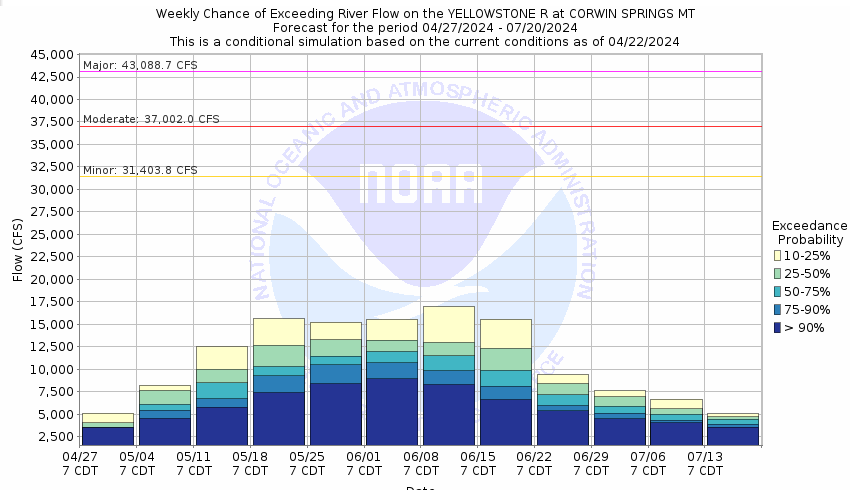
Flow outlook for the Yellowstone River at Corwin Springs. Note that this outlook was published prior to an early surge of spring melt in the last few days of April. This early surge may push the peak of runoff earlier.
Yellowstone Park Fisheries
All flowing water in YNP will see 2:00 closures in late July and August if we have a hot/dry summer. We do not anticipate any full closures in the park, even though all water downstream of geyser basins should really be closed from sometime in the first half of July until Labor Day.
Lakes in YNP: All except maybe Lewis and Shoshone should be accessible and ice-free on the opener and will fish best for the first month (assuming they are open; Blacktail Ponds opens in early July and will probably already be too warm). The hikes into the grayling lakes near Canyon will not be as muddy as usual in early June. You might not even want to hike in waders at all this year, a rarity…
Firehole, Gibbon, and Upper Madison Rivers: The Firehole will fish best from the opener until June 10 and may start seeing water temps over 70 degrees as early as June 10 below Midway Geyser Basin. It seems unlikely any portion below Biscuit Basin (the famous water) will be cool enough to fish well or ethically at all after June 20 unless we see an extremely cold June. The Lower Gibbon and Madison will be fishable on the opener. The Madison will fish best June 1 through 15. The Gibbon below Norris Geyser Basin will fish best from the opener to June 15 in the canyon either side of Gibbon Falls and June 1 through 20 in the meadows. The Madison and Gibbon below Norris will get too warm between June 20 and June 25. The stretch of the Gibbon upstream from Norris Geyser Basin will be clear enough to fish but ice water on the opener. It will really become fishable around June 5 and be best for the next month.
Yellowstone River (Grand Canyon): Will be high, difficult to wade, and murky but not unfishable for about two weeks at the beginning of the season, unless we stay cool and wet through May 15 and there’s a sudden surge of runnof for a couple weeks thereafter. We’ll be out of town for the opener, but we’d fish here if we weren’t. The fishing will be phenomenal with stonefly nymphs and streamers if you can handle the wading. Salmonflies will emerge after June 15 and be best June 20 through July 10. The best fishing will fade by late July, but this water will remain comparatively high and cold throughout the season and should get low enough to wade completely across in places (we won’t say where) by September 1, so this will probably be the best August and early September fishery in the region for those up for the hiking.
Gardner River: The Lower Gardner will have clear days and muddy days from the opening of the season on May 25 until about June 10, then be nymphable but too high to fish on the surface for about a week. All of this fishing is for strong waders only. Thereafter it will get slightly easier to wade and fish with dry-dropper combos. Salmonflies will hatch from June 15–20 until July 20 depending on section. The area below Boiling River will get too warm by July 10–15 and stay that way until late September. The area between Osprey Falls and Boiling River will stay cool enough but probably be busy into early August, then get a lot harder though not impossible. The upper water near Indian Creek will drop and clear enough for your beginner fishing needs around June 20. It will fish best for the month thereafter.
Yellowstone River (Elsewhere): The upper river near and above Yellowstone Lake opens July 1 and will be best for the three weeks thereafter. Normally we suggest waiting here until July 15 to let the trout finish spawning, but because of the low water and warm winter, they ought to be done by July 1 this year. The Black Canyon might see a few fishable windows in early June, but will really drop in around June 10–15 and be best for the month thereafter. Flows will be low and the fish spookier than normal in August and early September, but this water is tight enough and deep enough it will still fish okay if you get away from the crowds near Gardiner and Hellroaring (the crowds can actually be awful near Gardiner now) and water temps stay under 70 degrees.
Lamar River System: Slough might be fishable with streamers around the opener before blowing out, if all of May remains rather cool. Realistically, all three major waters in this basin (Lamar, Soda Butte, Slough) will come in between June 10 and July 25 depending on when the heaviest runoff begins and the stretch in question, and be best for the month thereafter. Late August and September will see extreme low water, unbearably crowded conditions, and beat-up fish. We suggest avoiding Soda Butte in particular after early August regardless of water temperatures, as it will just a trickle and the fish will be podded up and way too vulnerable in the few deep pools. Shooting wild cutthroats in a barrel will hurt future seasons and will say very ugly things about you as an angler. Let me put it this way: if you choose to fish Soda Butte Creek from August 10 until the fall rains hit, you are not welcome as a Yellowstone Country Fly Fishing client.
Creeks: Meadow streams will fall into shape around June 5 and be best from June 10 through July 10, except for those in the Gardner and Lamar systems which will come in between June 10 and June 20 and be best for the month after that. All will be trickles by early August. Rough mountain creeks will come in during late June and be best from around July 4 into early August, but will be trickles by late August.
Summary
We anticipate the prime summer fishing to begin roughly two weeks earlier than normal, around approximately June 15 depending on the specific water and May and early June weather. In particular there will be many more clear opportunities (such as the Yellowstone in the Grand and Black Canyons) starting in June than usual.
Unfortunately, the above means extremely low to record low flows and water that is too warm for trout health and ethical fishing in late summer. We anticipate widespread 2:00 closures from late July through most of August on all streams in Yellowstone Park and most Montana float fisheries. Even after closures are lifted with the longer nights and cooling water temps in late August, fishing will remain challenging due to low, clear water and spooky fish. Cooler, cloudy weather will fish okay in September and October (especially after the heavy fall rains hit, usually around September 20), but hot, bright days will remain difficult. Only extremely wet weather between now and then and a cool summer will save us from these conditions.
In addition, we expect significant fire danger and probably a lot of wildfires and smoke in late summer (though the smoke mostly comes from fires in WA and BC, not from local fires).
Because of the anticipated conditions, we suggest coming at least a couple weeks earlier in the season than usual, if you can, assuming you’re looking for your “usual” fishing conditions. Anglers also must be flexible in late July and August in order to work around expected 2:00 closures and poor conditions. Even in September, flexibility as to tactics, fishing destinations, and even target quarry will be very helpful in having successful trips. Anglers interested in pursuing carp on foot, from our drift boat, or even from our power boat will do much better than those who insist upon fishing specific waters using specific tactics for trout. Anglers who demand to fish Paradise Valley using dry flies in mid-August are probably going to have awful trips.
Let’s be clear: while there will still be a few good days mixed in here and there in late July and August when the weather is cloudy and cooler than normal, overall the trout fishing in late summer is going to be terrible. The more flexible anglers are, the more likely they are to bump this up to “fair.” Even in September, fishing is not going to be anywhere near as consistent as usual. Anglers who want the usual “Montana experience” really need to come early or very late in the prime season this year.
Our next full update will drop in mid-May when NOAA’s next long-range outlooks appear. We also suggest keeping an eye on our Facebook Page, our Instagram, and our Blog. We’ll post updates on windows of fishable clarity, the Yellowstone and Lower Madison’s Mother’s Day Caddis hatches, and the onset of the heavy spring runoff there. The caddis hatches are most likely to start before the next fishing forecast and streamflow update.